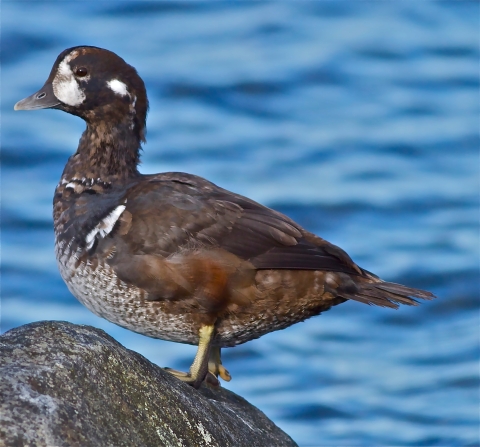Birders and other nature lovers often delight to see ducks on their outdoor adventures. Their larger size relative to songbirds can make ducks a strong starting point for beginning bird watchers. Male ducks are frequently highlighted and photographed because their brightly colored and distinctively patterned feathers make them easy to identify. Those colors and patterns aren’t for us though, they’re used to attract female members of their species. Female ducks don’t have to show off bright colors to find a mate and instead use their drab coloration to blend into their surroundings while nesting. This lack of bright colors means that they tend to get overlooked. Join us in giving the gals some love by learning more about our female ducks and how to identify them.
To start, let’s cover some duck basics. North American ducks fall into three main categories based on their feeding habits: divers, dabblers, and others.
Divers: These duck species dive deep underwater to catch and feed on their prey. You may spot a diving duck near a larger, deeper lake, river, or bay.
Dabblers: These duck species dabble or “tip” themselves upside down into the water in order to forage for food. You may spot a dabbling duck near shallow, freshwater marshes, rivers, or ponds.
Others: This category covers any species that do not feed either by diving or dabbling. Whistling ducks are the main group in this category.
Let’s take a look at some of the fantastic, flying females in each of these categories!
Divers
Harlequin Duck (Histrionicus histrionicus)
Harlequin ducks are a unique species, primarily found in the northern coastal areas of North America and Asia. In the U.S., they can be found year-round on the southern coast of Alaska, the Aleutian Islands, and the coast of New England. During their breeding season, the ducks migrate north into inland Alaska and Canada. Harlequin hens can be identified by their brown head and body, as well as a white spot behind their eye and a white patch found at the base of their bill.
Hooded Merganser (Lophodytes cucullatus)
The hooded merganser is one of several diving ducks that can be found in almost all of the U.S. Year-round, hooded mergansers can be found throughout the eastern half of the country. During their breeding season, they travel farther north into Canada. During migration and outside of breeding season, groups can also be found throughout the western half of the country, even as far west as California. Hooded merganser hens can be identified by their grayish-brown body and their brown head crest.
Dabblers
Mallard (Anas platyrhynchos)
The mallard is one of the most common duck species found in North America. Year-round, these ducks can be found throughout most of the continental U.S., but they might be spotted as far north as Alaska during the breeding season. The males are known for their distinctive green-feathered heads, but mallard hens have an orange and black bill with body feathers in various shades of brown. Both males and females have a distinctive blueish purple wing patch with white bands.
Wood Duck (Aix sponsa)
The wood duck is found throughout the eastern U.S. and parts of the Pacific Northwest year-round, though it can sometimes be found in the western U.S. Wood duck hens, like the one seen here with her babies, are identified by their white eye patch, white underside, brown back feathers, and tan and gray sides. Both male and female wood ducks have bright blue wing patches.
Others
Ruddy Duck (Oxyura jamaicensis)
The ruddy duck, known for the male’s bright blue bill, can be found throughout the continental U.S. during their breeding and migration seasons. The female ruddy duck lacks the bright blue bill found in her male counterpart but can instead be identified by the brown stripe dividing her white cheek patch. A ruddy duck hen’s body is covered in mottled grayish-brown feathers.
Fulvous Whistling Duck (Dendrocygna bicolor)
Last but not least is the fulvous whistling duck. These ducks get their name from their calls, which sound like whistling. Though this species is primarily found in Mexico and central America, it inhabits the Gulf Coast during breeding season. Unlike our other species, these and other whistling ducks have round wings and legs that trail behind them when flying. Males and females have very similar black-brown back feathers and cinnamon undersides, though the females are slightly duller and smaller.
Next, time you find yourself outside, try to apply your new knowledge and identify any ducks you encounter!









